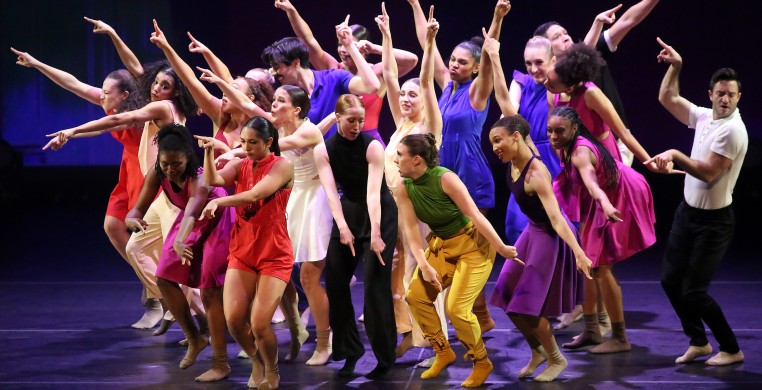South Chicago Dance Theatre made its Auditorium Theatre debut with the World Premiere of executive artistic director Kia S. Smith’s “Memoirs of Jazz In The Alley,” for a one-night-only performance Saturday night, June 10th. The performance was part of the Auditorium’s “Made In Chicago” series.
Smith’s first evening-length piece, “Memoirs..." is a tour de force and a sensory immersion into this artist’s creative well-springs. The fictionalized memoir-in-motion draws upon her memories of the jazz music she heard and the personalities she observed growing up in Chicago’s jazz community, as well as from archival materials.
“Jazz in the Alley” began with lights coming up on tiers of gauze drapes hung ceiling to floor from the flies. Dancers migrate, pedestrian-style, across the corridors of time, dream-like, as they lead us into memory.
The Sandman, an enigmatic Trey Alexander (who also designed the costumes), emerges, transcending the gauzy corridors, to assume their role as the narrator/oracle and movement master of ceremonies for the evening’s festivities. They reach to the floor, scoops up an imaginary treasure, perhaps the sifting sands of TIME, which they offer up as a libation. Dressed in white culottes and tunic, their tall, lean frame erupts in angular gestures, thrusting into space with mechanical force, fists clenched in stop-action beats that melt just as suddenly into the ease and flow of floating. Their movement is at once riveting and bizarre for its otherworldly contortions and non-sequiturs, drawing from Smith’s unique movement vocabulary. They kneel, open thier mouth in a silent scream. Sudden gut-punches interrupt fluid torso contractions, while flexed feet and tight-fisted hands combat space, then suddenly relent. The chorus mirrors thier gesture.
The piece evokes Smith’s memories of her father, who was, as she says in her program notes, “the progenitor of live music that took place for decades in the once popular sociocultural happening, ‘Jazz In The Alley.’” Her mother “was a fixture at the historic Jazz Showcase.”
The non-linear story compiles imagined scenes and personalities Smith drew upon from the photos taken by her father. We experience the cumulative effect of the two-act production through the eyes, mind, body and soul of The Girl In Red, stunningly danced by Kim Davis.
The soundscape consists of arrangements from jazz archives and newly-composed music, all by Isaiah Collier and performed by The Chosen Few. Smith’s own constructs of synthesized sound and musical segments augment the score.
Elaborate projection designs by Rasean Davonté Johnson, and Julie Ballard’s exquisite lighting design were integral partners with the choreography and dancing. Ballard also served as production manager, which must have felt like taming a multi-tentacled hydra on a roller-coaster ride that dipped and ascended into past and future through what Smith characterizes as “a futuristic retro lens.”
 SCDT dancers perform in front of projections by Rasean Davonté Johnson, lighting design by Julie Ballard; Photo by Andy Argyrakis
SCDT dancers perform in front of projections by Rasean Davonté Johnson, lighting design by Julie Ballard; Photo by Andy Argyrakis
Smith accomplishes this through rhythmic episodes that contrast the projected images of conflagration, weapons of mass destruction, and Armageddon on the cyclorama upstage with the happy-go-lucky social dance forms from the 20’s, 30’s and 40’s taking place on the stage floor below.
The projections take us to an Edwardian drawing room, outer space, and aboard an ocean liner with an enormous porthole—perhaps to the future—at the same time as the choreography drops contemporary, jazz, ballet and modern dance into the mix of the Charleston, The Lindy Hop, and Swing.
Futuristic sounds intrude momentarily upon historic jazz recordings as the solos, duets, trios and full ensemble segments play out.
The Girl In Red (Davis) provides the dramatic through-line, with solo interludes of her evolving emotional state, from flirtatious party girl to rape victim to sister of solidarity. Scenes with her love interest, portrayed with alternating tenderness and brutality by Elijah Richardson, provide context as well as fluid choreographic transitions from one scene to the next, while Kelly Anderson acts as best friend/confidant, mirroring Davis's sexual tension and emotional ambiguity in a star turn of her own.
In the end, we are left with a lot of really great dancing: virtuoso solos by ensemble members Ricky Ruiz, Zachary Heller, and Jesse Hoisington, and especially by Davis, who dazzles with a fiery technique and depth of dramatic range.
Not to be forgotten, the superb ensemble of twenty dancers executed Smith’s snappy choreography and fascinating spatial designs with razor-sharp musicality, skilled acting chops, and technique that says “WOW!”
With all that, what do we take away from “Memoirs of Jazz In The Alley?” First and foremost, “Memoirs…” leaves us with a love for the music and for the people who made it. Leaving the theater, I carried away a sense of overall sensory delight, but upon waking up the next morning, a deeper message had penetrated. Perhaps Smith’s look into the complexities of memory has revealed to her, and to us, that life is full of contradictions, joy and disillusionment, wonder and heartache, and that nostalgia for the good old days masks some hard-earned truths.
-----------------------
For more details on Kia Smith’s creative process for “Memoirs…,” check out an interview with Smith and See Chicago Dance here.



